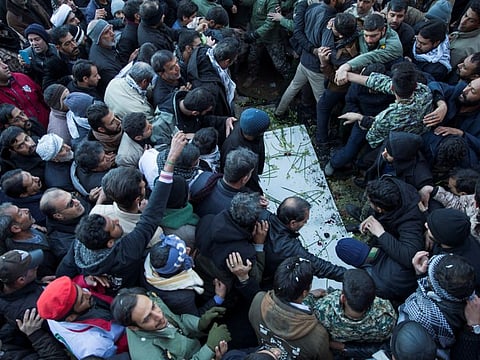Soleimani’s death offers a chance to fix US policy on Syria
Trump administration can push forward a political solution that stops ongoing slaughter

It’s no coincidence that Qasem Soleimani’s final stop before arriving in Baghdad was Damascus, where he played a major role overseeing the Assad regime’s war on civilians. Soleimani’s death leaves a huge power vacuum in Syria that presents a rare opportunity for the United States to fix its broken Syria policy.
Soleimani’s role in Syria — especially when it comes to intensifying the brutality the Assad regime has inflicted on innocents there — cannot be overstated. He orchestrated the campaign to fight the rebels by attacking civilian populations, using tactics that include war crimes. He called on all the proxy militias connected to his Quds Force of the Revolutionary Guard Corps to join the fight. And he facilitated the flow of weapons and cash to them from Iran.
The US government first sanctioned Soleimani “for providing support to the Syrian regime’s violent repression of dissent” in 2012. “Qasem Soleimani is now running Syria,” a rebel commander told the Wall Street Journal in 2013. “Bashar is just his mayor.”
Iran sees Syria as part of its “axis of resistance” against the West. An official close to Supreme Leader Ayatollah Ali Khamenei, Mehdi Taeb, once called Syria Iran’s “35th province” and said “if we lose Syria we won’t be able to hold Tehran.”
Trump administration could maximise its leverage in Syria right now by implementing new sanctions on Assad under legislation just signed by President Trump called the “Caesar Act.” That is crucial to keeping Assad diplomatically isolatedJosh Rogin
“Soleimani orchestrated the wide-scale ethnic cleansing of Sunni villages and cities throughout Syria. These crimes fuelled radicalism and led to the rise of Daesh which continues to plague the people of the region,” said Mouaz Moustafa, executive director of the Syrian Emergency Task Force. “But the killing of civilians that Soleimani helped facilitate in Syria will not end with his death.”
Series of bold moves
The question is whether the US government and its partners can take advantage of this important but fleeting moment when the Assad regime has lost its most important international patron and Iranian proxy forces in Syria have lost their leader. Trump administration officials and lawmakers are just now thinking through how the Soleimani killing impacts Syria and how US policy can respond.
“A weakened Iran means a weakened Assad, and that’s good for the Syrian opposition,” Sen. Lindsey Graham, told me. “Killing Soleimani was a bold move, and it’s going to require a series of bold moves in order to be successful.”
The United States and its partners should exert more force on Russia to pressure Assad to make political concessions, Graham said. Russian President Vladimir Putin raced to visit Assad in Damascus days after the Soleimani strike.
Russia has been taking heat for its own war crimes in Idlib and for its efforts to stop the flow of humanitarian aid to civilians in liberated areas. It was Soleimani who personally persuaded Putin to intervene in Syria in 2015. With him out of the picture, Putin might be looking for a political solution that allows Russia to draw down.
The Trump administration could maximise its leverage in Syria right now by implementing new sanctions on Assad under legislation just signed by President Trump called the “Caesar Act.” That is crucial to keeping Assad diplomatically isolated.
Sand and death
Trump himself could easily help a lot by clearly stating the US commitment to keep US troops in Syria. There are about 600 US troops sitting on oilfields in Deir al-Zour province and several hundred more in a base called Tanf near the Iraqi border. These are the exact areas Soleimani sought to control to facilitate the flow of Iranian weapons and fighters throughout the region.
Syria has always been the glaring gap in the Trump administration’s strategy to stop Iran’s malign activity in the region. Trump has dismissed Syria as a place of “sand and death” and twice announced (and then reversed) the withdrawal of US troops, which directly enabled the Assad regime and Iranian militias to expand their control.
If only Trump would realise that Syria is the place where the Iranian regime is most overextended and most vulnerable, he might be able to actually implement the “maximum pressure” policy on Tehran his officials constantly tout. No effort to contain Iran’s regional mischief can succeed without confronting them in Syria.
The Soleimani strike, if combined with more economic pressure on Iran and its proxies and partners, could seriously diminish Iran’s ability to project power in the region. It might also provide new leverage for the United States to push forward a political solution in Syria that stops the ongoing slaughter.
—Washington Post
Josh Rogin is a prominent American columnist, political analyst and foreign policy expert.
Also Read: Need for a new Arab Strategy
Sign up for the Daily Briefing
Get the latest news and updates straight to your inbox



